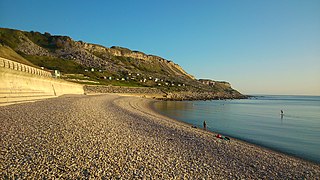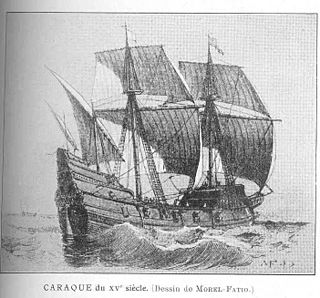
Slapton is a village and civil parish in the South Hams district of Devon, England. It is located near the A379 road between Kingsbridge and Dartmouth, and lies within the South Devon Area of Outstanding Natural Beauty (AONB). The nearby beach is Slapton Sands; despite its name, it is not a sandy beach but a shingle one.

Chesil Cove is a curved steep bank forming the south-east end of 29-kilometre (18 mi) Chesil Beach in Dorset, England. It is thus part of one of three large shingle structures in Britain, extending from West Bay to the Isle of Portland, the latter acting more firmly as a great barrier (groyne) which stops tidal action from washing the beach away and leads to the high depositions by wind and tide action forming the grand curved bank of this "cove". The "cove", bill and much of Chesil Beach give shelter from the prevailing winds and waves for much of Weymouth Bay, the town of Weymouth and the village of Chiswell. It forms part of the Jurassic Coast.

Gunwalloe is a coastal civil parish in Cornwall, England, United Kingdom. It is situated on the Lizard Peninsula three miles (4.8 km) south of Helston and partly contains The Loe, the largest natural freshwater lake in Cornwall. The parish population including Berepper at the 2011 census was 219. The hamlets in the parish are Chyanvounder, Berepper and Chyvarloe. To the east are the Halzephron cliffs and further east the parish church.

HMS Resolution was a 70-gun third-rate ship of the line of the Royal Navy, launched at Harwich Dockyard on 6 December 1667. She was one of only three third-rate vessels designed and built by the noted maritime architect Sir Anthony Deane.

Hanover was a two-masted brigantine packet ship owned and operated by the Falmouth Post Office Packet Service, which operated between 1688 and 1852.

The Salcombe Cannon wrecksite is close to two other designated wrecksites in the Erme Estuary which the South West Maritime Archaeological Group (SWMAG) was licensed to investigate. In 1992 this group described the Salcombe Cannon site as:
Cattewater Wreck is a wooden three-masted, skeleton-built vessel, one of many ships that have wrecked in Cattewater, Plymouth Sound, England. This wreck is close to the entrance of Sutton Harbour, its name is still unknown but it is believed to be from the 16th century. It is a Protected Wreck managed by Historic England.

Downderry is a coastal village in south-east Cornwall, England, United Kingdom. It is 12 miles (19 km) west of Plymouth and one mile east of Seaton.
Hannah Elizabeth was built in 1829 in Stonington, Connecticut. Records of the time describe her as being a two-masted schooner, 67 feet long and 20 feet wide. At the time of the sinking her weight was listed as 74 tons, also recorded was that she was armed with three cannons; two 6-pounders and one 4-pounder.

The Royal Adelaide was an iron sailing ship of 1400 tons built by William Patterson at Bristol in 1865.
The Blackfriars shipwrecks were a series of wrecks discovered by archaeologist Peter Marsden in the Blackfriars area of the banks of the River Thames in London, England. The wrecks were discovered while building a riverside embankment wall along the River Thames. Marsden discovered the first on 6 September 1962 and the other three were discovered in 1969–1970. Together they are now known as the four Blackfriars wrecks.

San Esteban was a Spanish cargo ship that was wrecked in a storm in the Gulf of Mexico on what is now the Padre Island National Seashore in southern Texas on 29 April 1554.
The Cirebon shipwreck is a late 9th to 10th-century shipwreck discovered in 2003, in the Java Sea offshore of Cirebon, West Java, Indonesia. The shipwreck contains a large amount of Chinese Yue ware, and is notable as important marine archaeology evidence of the Maritime Silk Road trading activity in Maritime Southeast Asia.
The Kennemerland was a Dutch East Indiaman that was lost off the Out Skerries, Shetland, in 1664. It was carrying cargo from the Netherlands to the Dutch East Indies, and had taken the northern route to avoid interception by the English, since the Second Anglo-Dutch War was expected to start soon. There were just three survivors. The islanders salvaged what they could, but there were disputes over ownership of the spoil. The vessel's excavation in the 1970s was one of the earliest exercises in the new discipline of maritime archaeology.
The Bartholomew Ledges Wreck is a wreck found in the late 1970s at St Marys Sound, Isles of Scilly is believed to be that of a mid-sixteenth to early seventeenth century armed cargo vessel. The site was designated under the Protection of Wrecks Act on 23 September 1980. The wreck is a Protected Wreck managed by Historic England.
The remains of an apparent armed wooden sailing vessel were identified in 2010 on The Downs, Kent, England. The site was designated under the Protection of Wrecks Act on 3 August 2012. The wreck is a Protected Wreck managed by Historic England.
The Tearing Ledge Wreck consists of the remains of a ship, possibly one of the ships belonging to Admiral Cloudisley Shovell's fleet of 21 vessels returning from the Siege of Toulon via Gibraltar, that were found in 1969 on Tearing Ledge, Western Rocks, Isles of Scilly. The site was designated under the Protection of Wrecks Act on 12 February 1975. The wreck is a Protected Wreck managed by the National Heritage List for England.
The remains of a seventeenth century cargo vessel were identified in Gunwalloe fishing cove, Cornwall in 1998. The site was designated under the Protection of Wrecks Act on 23 May 1999. The wreck is a Protected Wreck managed by Historic England.

The Rill Cove Wreck is an underwater wreck of a 16th-century Spanish cargo ship lying off the coast of Rill Cove, west of Kynance Cove, in Cornwall, England, UK.









